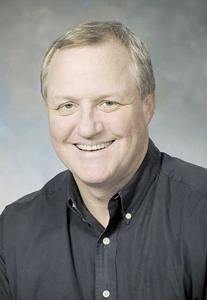Editorial
Front Page - Friday, January 7, 2011
Are we there yet?
More passings
Jay Edwards

It is not an unusual sight for me to look up and see my daughter Alexis with her face in a book. So when I interrupted her, as she navigated the ottomans and coffee tables with ease, never coming close to a bump on her shin or a stubbed toe, it was only to remark at her choice of bound paragraphs.
“You’re reading “Catcher in the Rye” again?” I asked her. “No, it’s my first time,” she told me. “I think I’m the only person I know who hasn’t read it. Have you?”
“A long time ago, but it was after high school and even college, I was sullen enough on my own without Holden Caulfield guiding me.”
She laughed, which I appreciated, and was back to it, trying to finish another of the self-imposed readings of youth.
“I love to write and I assure you I write regularly,” Jerome David Salinger said in a rare interview, “but I write for myself, for my own pleasure. And I want to be left alone to do it.” He pretty well laid out then just how important his privacy was to him.
Salinger was born on New Year’s Day in 1919, less than two months after the world’s first great war had ended and the same day Edsel Ford succeeded his father as head of Ford Motor Co., for what it’s worth. His mother, Marie, was Irish Catholic and his father, Sol, a Lithuanian Jew who imported and sold cheese.
At McBurney School in Manhattan, Salinger was less than a good student and his parents sent him to a military academy after McBurney asked him to leave. It was there, at the Valley Forge Academy, where Salinger began writing stories late at night, “under the covers with the aid of a flashlight.”
After dropping out of New York University, Salinger was sent to Vienna, by his father, to work and learn about the meat-importing business. He left Austria in March of 1938, a month before the Nazis moved in.
In 1941 he began dating playwright Eugene O’Neill’s daughter Oona, but she left him to date Charlie Chaplin, whom she later married. In 1942 he was drafted into the Army, where he saw combat with the 12th Infantry Regiment, 4th Infantry Division. He was active at Utah Beach on D-Day and in the Battle of the Bulge.
It was during this time of the war that he became acquainted with Ernest Hemingway who said of Salinger’s writing, “Jesus, he has a helluva talent.”
Salinger was assigned to counter-intelligence. He spoke fluent French and German, interrogating prisoners. He was also one of the first soldiers to enter a liberated concentration camp, of which the disturbing images would stay with him forever. He once told his daughter, “You never really get the smell of burning flesh out of your nose entirely, no matter how long you live.”
His novel about the cynical adolescent Caulfield, and likely himself, has sold 65,000,000 copies around the world.
Salinger died on January 27, 2010 at the age of 91.
•••
Life began hard in 1925 for young Bernard Schwartz. His parents were Hungarian Jews who lived in the northernmost of New York City’s five boroughs known as The Bronx and until he was five the only language young Bernard spoke was Hungarian. During that childhood his mother, who once appeared on “You Bet Your Life,” with Groucho Marx, was diagnosed with schizophrenia. “When I was a child, Mom beat me up and was very aggressive and antagonistic,” Bernard said.
When he turned eight he was put in an orphanage with his brother Julius because their parents couldn’t afford to feed them. Four years later Julius was hit and killed by a truck. Bernard joined a street gang and had it not been for the kindness of a neighbor who sent him to a Boy Scout Camp, would have led a much different life.
After the Japanese bombed Pearl Harbor Bernard enlisted and chose submarine duty. And on September 2, 1945 he would watch from the bridge of his sub as the Japanese surrendered in Tokyo Bay.
After the war he returned to New York and got into the Dramatic Workshop of The New School, where he studied with Rod Steiger and Walter Matthau. He was placed under contract with Universal Studios but wasn’t confident about his career, writing, “I was a million-to-one shot, the least likely to succeed. I wasn’t low man on the totem pole, I was under the totem pole, in a sewer, tied to a sack.”
Nevertheless he would appear in over 120 films in a career that lasted six decades; and was nominated for an Oscar for his role in “The Defiant Ones.”
Bernard Schwartz, aka Tony Curtis, died September 29, 2010 at the age of 85.
|
|